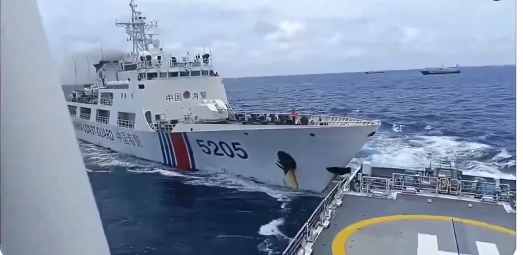The waters of the South China Sea are restless once more, a vast blue expanse becoming a chessboard for power plays and territorial posturing. On Saturday, tensions flared yet again as China and the Philippines found themselves locked in a blame game over a collision between their coast guard vessels. The Philippines accused a Chinese ship of deliberately ramming its vessel, a claim that Beijing quickly flipped on its head, accusing the Philippines of intentionally crashing into them. This latest confrontation, near the contested Sabina Shoal, is just another chapter in a story that seems to have no end, a saga marked by escalating disputes and deep-seated distrust.
#WATCH ⚡️
Chinese Coast Guard vessel intentionally rams Philippine Coast Guard ship THREE TIMES near Escoda Shoal in the South China Sea. A reckless and aggressive move that threatens regional security. #SouthChinaSea #Philippines #China pic.twitter.com/8GZPgMC5R9— WarNewsNow (@WarNewsNow55) August 31, 2024
The Sabina Shoal—Xianbin Jiao to the Chinese, Escoda Shoal to the Filipinos—sits in a region fraught with historical grudges and modern ambitions. It’s just 75 nautical miles from the Philippines’ western shores but over 600 nautical miles from China’s coast. This shoal is not just a dot on a map; it’s a symbol of the larger battle for dominance in the South China Sea, a crucial artery for global trade where $3 trillion worth of goods pass through each year. And while China lays claim to nearly the entire sea, overlapping claims from the Philippines, Brunei, Malaysia, Taiwan, and Vietnam make these waters some of the most disputed on Earth.
In the wake of this latest clash, China’s coast guard issued a stark demand: the Philippines must withdraw from Sabina Shoal, promising to thwart any acts of “provocation, nuisance, and infringement.” Yet the Philippines, steadfast and unyielding, refused to retreat. The Teresa Magbanua, their vessel that bore the brunt of the clash, remains at its post, damaged but defiant. “Despite the harassment and bullying,” the message from Manila was clear: they won’t be intimidated.
All Filipinos should be voting for Trump if they have a HOPE for the FUTURE – Kamala is wholly UNPREPARED to be burdened by this China aggression
🚨Tensions are rising in the highly contested South China Sea, where China’s increasing aggression towards the Philippines could be… pic.twitter.com/i5qUARgXPX
— 🇺🇸 ʟᴇғᴛ ᴄᴏᴀˢᴛ ᴠᴀɢʀᴀɴᴛ 🇺🇸 (@Baklava_USA) August 31, 2024
The situation has drawn sharp rebukes from afar, with U.S. Ambassador to the Philippines MaryKay L. Carlson condemning China’s actions as “dangerous violations of international law.” She declared unequivocal support for the Philippines, reinforcing a stance that these waters are not just a regional concern but a matter of global significance. As the U.S. steps up to back its ally, Beijing accuses Washington of emboldening Manila to provoke further.
Beijing Slams Manila’s “Dangerous” Move As China, Philippines Ships Collide Again In Sabina Shoal
The Philippines and China on August 31 accused each other of intentionally ramming into each other’s coast guard ships in disputed waters of the South China Sea. The collision near… pic.twitter.com/kUyHOlCdOU
— Point Blank News (@_pblanknews) August 31, 2024
Amid this tense standoff, the specter of a larger confrontation looms. These waters, already fraught with danger and disputes, could easily become the flashpoint for a broader conflict. Yet, amidst the clashes and the rhetoric, there have been glimmers of compromise. Just last month, both countries agreed to let the Philippines restock its outpost on the Second Thomas Shoal, a rare moment of cooperation in an otherwise turbulent sea.
But peace here is as fleeting as a summer storm—beautiful in its brief calm, ominous in its potential to erupt once more. The South China Sea remains a place where ancient rivalries meet modern might, where every wave carries with it the weight of history and the uncertainty of what comes next.
Major Points
- A collision between Chinese and Philippine coast guard vessels near the contested Sabina Shoal has sparked a new round of accusations, with both sides blaming each other for the incident.
- The Sabina Shoal, located much closer to the Philippines than China, symbolizes the broader territorial disputes in the South China Sea, a region with overlapping claims from several countries.
- China demanded the Philippines withdraw from the shoal, threatening further actions to prevent any “provocation,” while the Philippines stood firm, refusing to back down despite the confrontation.
- The U.S. condemned China’s actions, reaffirming its support for the Philippines and highlighting the global importance of maintaining international law in the region.
- While there have been moments of cooperation between China and the Philippines, the South China Sea remains a highly volatile area, with the risk of further conflict always present.
Conner T – Reprinted with permission of Whatfinger News


